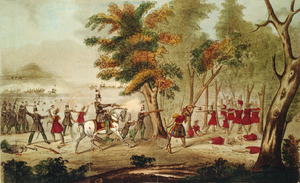
Back تیمز چایی دؤیوشو AZB Schlacht am Thames River German Batalla del Támesis Spanish نبرد تیمز Persian Thamesin taistelu Finnish Bataille de la rivière Thames French Thames folyó menti csata Hungarian Pertempuran Thames ID テムズの戦い Japanese 테임즈 전투 Korean
| Battle of the Thames | |||||||
|---|---|---|---|---|---|---|---|
| Part of Tecumseh's War and the War of 1812 | |||||||
 An artist's depiction of the battle and the death of Tecumseh | |||||||
| |||||||
| Belligerents | |||||||
|
Tecumseh's confederacy |
| ||||||
| Commanders and leaders | |||||||
|
Tecumseh † |
| ||||||
| Strength | |||||||
|
3,760+: | ||||||
| Casualties and losses | |||||||
|
Indigenous: 16–33 killed[4][5] Unknown wounded and captured British: 12–18 killed 22–35 wounded prisoners 566–579 captured[6][7] |
10–27 killed 17–57 wounded[8][9] | ||||||
Location within Ontario | |||||||
The Battle of the Thames /ˈtɛmz/, also known as the Battle of Moraviantown, was an American victory in the War of 1812 against Tecumseh's Confederacy and their British allies. It took place on October 5, 1813, in Upper Canada, near Chatham. The British lost control of Southwestern Ontario as a result of the battle; Tecumseh was killed, and his confederacy largely fell apart.
British troops under Major General Henry Procter had occupied Detroit until the United States Navy gained control of Lake Erie, cutting them off from their supplies. Procter was forced to retreat north up the Thames River to Moraviantown, followed by the tribal confederacy under Shawnee leader Tecumseh who were his allies.
American infantry and cavalry under Major General William Henry Harrison drove off the British and then defeated the Indigenous peoples, who were demoralized by the death of Tecumseh in action. American control was re-established in the Detroit area, the tribal confederacy collapsed, and Procter was court-martialed for his poor leadership.
- ^ a b c d e "Battle of the Thames | War of 1812".
- ^ Battle of Moraviantown
- ^ a b c d Sugden (1997), pp. 368–72
- ^ Sugden, p. 133
- ^ Gilpin, p. 226
- ^ Sugden, p. 127
- ^ Antal, p. 347
- ^ Sugden, p. 249
- ^ Sugden, p. 250, citing Samuel R. rown's, 'Views of the Campaigns of the North-western Army", W.G. Murphey, Philadelphia, 1815 (first published, 1814), p. 73

